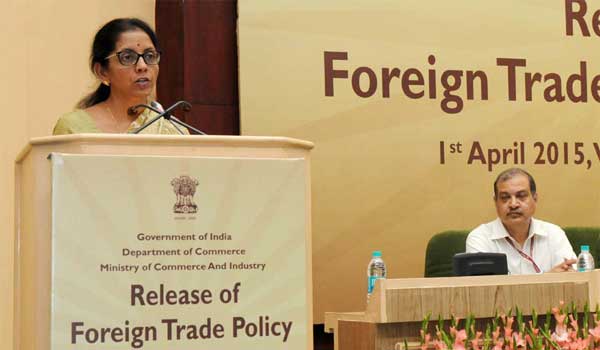New Delhi, April 2 With Prime Minister Narendra Modi’s “Make in India” initiative in the backdrop and a target of raising India’s exports to $900 billion by 2020, a new five-year Foreign Trade Policy was unveiled on Wednesday that recasts all external commerce programmes into two schemes.
“The new five-year Foreign Trade Policy, 2015-20 provides a framework for increasing exports of goods and services, as well as generation of employment and increasing value addition in the country, in keeping with the “Make in India” vision of the prime minister,” Commerce Minister Nirmala Sitharaman said.
“The focus of the new policy is to support both the manufacturing and services sectors, with a special emphasis on improving the ease of doing business,” she said during the unveiling of the new policy at the Vigyan Bhavan here.
In its blueprint for enhancing exports, she said, the government has now merged all the earlier export promotion projects under two plans – the Merchandise Exports from India Scheme (MEIS) and the Served from India scheme (SFIS) for services exporters.
As part of this initiative, the import duty exemption scrips valued at 10 percent of the foreign exchange earned, which are given to service exporters as an incentive, have now been made “tradeable” and can be used for service tax, customs and excise duty payments.
“There is no conditionality in any of the scrips issued under these two schemes,” Sitharaman said, adding: As a measure to boost special economic zones, units within them will also now be able to avail the benefit of the two merged schemes.
The new policy has come at a time when India’s merchandise exports continue to log a decent growth, having expanded by just 0.88 percent in the first 11 months of the current fiscal.
Declining for the straight third month, India’s exports fell by over 15 percent to $21.54 billion in February, even as the trade deficit narrowed to $6.85 billion on the back of declining international crude oil prices.
The commerce minister unveils the country’s Foreign Trade Policy for five years and a review is conducted annually. The previous policy was for 2009-2014, but neither was a new policy announced in 2014, nor a review conducted.
By implementing the new policy, India’s share in world trade is expected to double from the present level of three percent by 2020.
Indian industry welcomed the new policy in which trade facilitation and enhancing the ease of doing business are the other major focus areas.
Hailing it as a path-breaking policy, the Federation of Indian Export Organisations (FIEO) said the new policy recognises the global challenges faced by the export sector and also identifies the sectors which could emerge as winners in five years.
“The new Foreign Trade Policy has put the focus on states as all factors of production are within the ambit of states.
“Developing an export strategy, setting up of institutional support of Export Commissioners and formation of the Council for Trade Promotion and Development would involve states in export promotion which was seriously lacking,” FIEO president S.C. Ralhan said in a statement.
“Federation of Indian Chambers of Commerce and Industry is very happy to see several of its suggestions have been adopted.
“Concerted and partnership-based efforts of government and business would certainly be able to raise India’s share in world exports from the present level of 2 percent to 3.5 percent by 2019-20,” A. Didar Singh, secretary general, FICCI, said in a statement here.
“Indian industry is thrilled with announcements pertaining to simplification in procedures. Overall, the focus of the new policy is to support both the manufacturing and services sectors, with a special emphasis on improving the ‘ease of doing business’,” said industry chamber CII director general Chandrajit Banerjee.
Highlights of Foreign Trade Policy 2015-20:
* Increase exports to $900 billion by 2019-20, from $466 billion in 2013-14
* Old promotion schemes subsumed under two schemes – “Merchandise Exports from India Scheme (MEIS)” and “Services Exports from India Scheme (SEIS”).
* Higher level of rewards under MEIS for export items with high domestic content and value addition.
* Incentives extended to units located in special economic zones (SEZs.
* Export obligation reduced to 75 percent to promote domestic capital goods manufacturing.
* Duty credit scrips made freely transferable and usable For payment of custom duty, excise duty and service tax.
* Mainstreaming of state governments and various ministries in formulating FTP
* FTP will be reviewed after two-and-a-half years.
* Agricultural and village industry products would be supported across the globe at the rates of 3 percent and 5 percent.
* Focus on defence, pharma, environment-friendly products and value-added exports.
